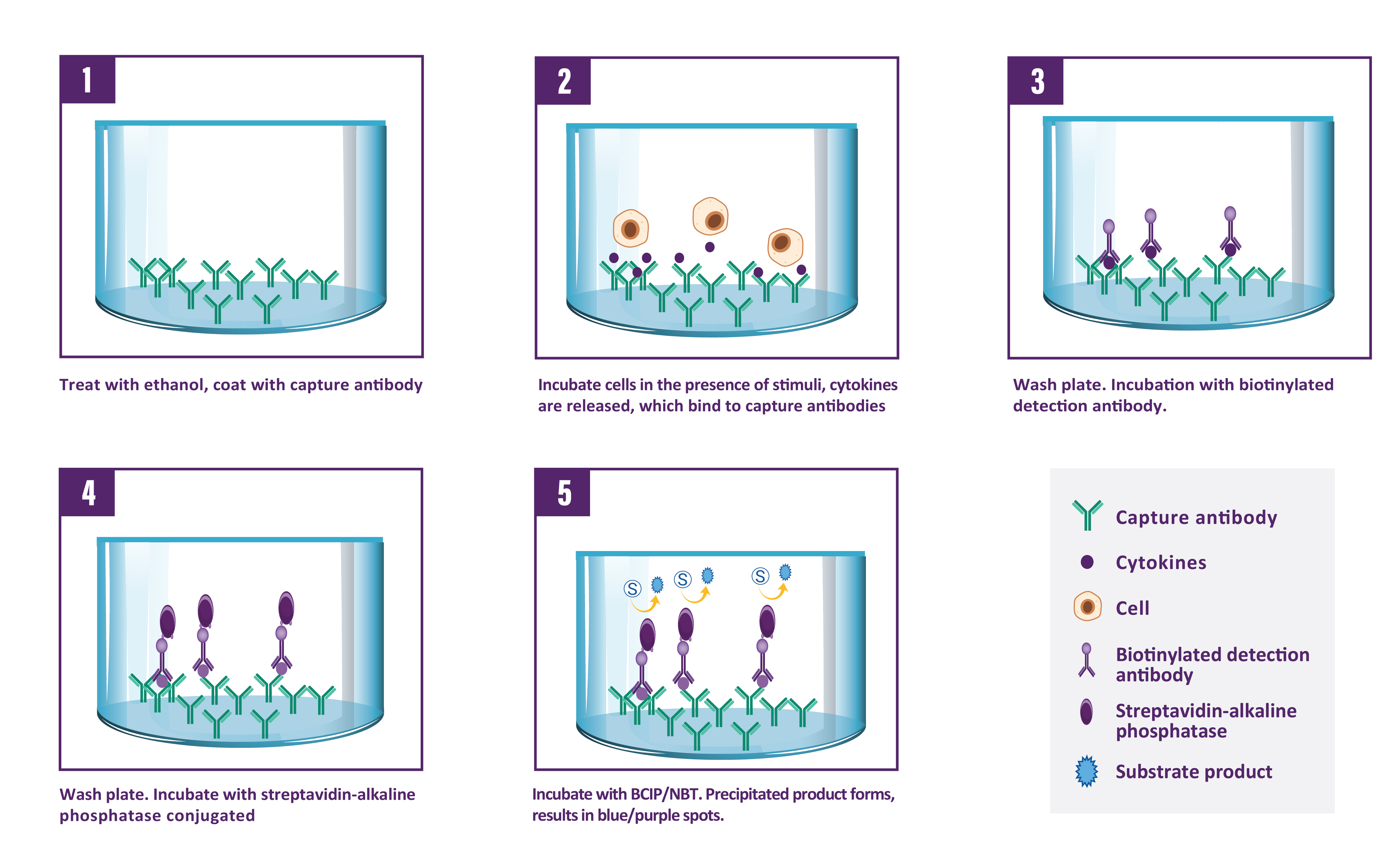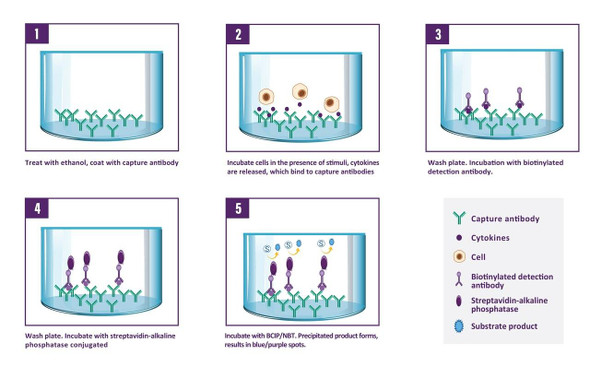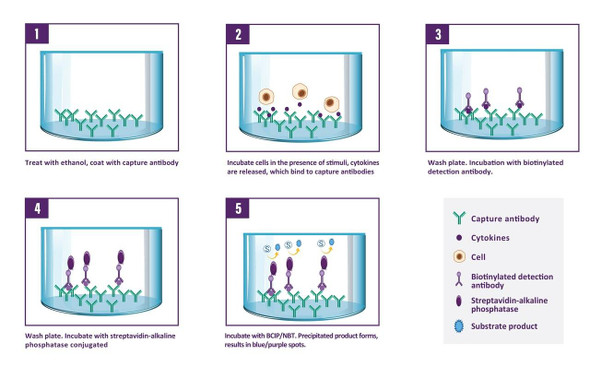Description
Human IL-4 ELISpot Pair
Assay Genie ELISpot is a highly specific immunoassay for the analysis of IL-4 production and secretion from T-cells at a single cell level in conditions closely comparable to the in-vivo environment with minimal cell manipulation. This technique is designed to determine the frequency of IL-4 producing cells under a given stimulation and the comparison of such frequency against a specific treatment or pathological state. Utilising sandwich immuno-enzyme technology, Assay Genie ELISpot assays can detect both secreted IL-4 (qualitative analysis) and single cells that produce IL-4 (quantitative analysis). Cell secreted IL-4 is captured by coated antibodies avoiding diffusion in supernatant, protease degradation or binding on soluble membrane receptors. After cell removal, the captured IL-4 is revealed by tracer antibodies and appropriate conjugates.
| Product type: | ELISpot Pairs |
| Size: | 10 x 96 Assays |
| Target species: | Human |
| Specificity: | Recognizes natural human IL-4 |
| Incubation: | |
| Kit content: | Assay Genie ELISpot matched antibody pairs are extensively validated and include pre-titrated capture antibody and biotinylated detection antibody. Antibodies are supplied in quantities sufficient for 10 x 96 samples. |
| Synonyms: | N/A |
| Uniprot: | P05112 |
A capture antibody highly specific for IL-4 is coated to the wells of a PVDF bottomed 96 well microtitre plate either during kit manufacture or in the laboratory. The plate is then blocked to minimise any non-antibody dependent unspecific binding and washed. Cell suspension and stimulant are added and the plate incubated allowing the specific antibodies to bind any IL-4 produced. Cells are then removed by washing prior to the addition of Biotinylated detection antibodies which bind to the previously captured IL-4. Enzyme conjugated streptavidin is then added binding to the detection antibodies. Following incubation and washing, substrate is then applied to the wells resulting in coloured spots which can be quantified using appropriate analysis software or manually using a microscope.

| Step | Procedure |
| 1. | Add 100 µl of PBS 1X to every well. |
| 2. | Incubate plate at room temperature (RT) for 10 min. |
| 2. | Incubate plate at room temperature (RT) for 10 min. |
| 3. | Empty the wells by flicking the plate over a sink & gently tapping on absorbent paper. |
| 3. | Empty the wells by flicking the plate over a sink & gently tapping on absorbent paper. |
| 4. | Add 100 µl of sample, positive and negative controls cell suspension to appropriate wells providing the required concentration of cells and stimulant. |
| 5. | Cover the plate and incubate at 37°C in a CO2 incubator for an appropriate length of time (15-20 hours). Note: do not agitate or move the plate during this incubation. |
| 6. | Empty the wells and remove excess solution then add 100 µl of Wash Buffer to every well. |
| 7. | Incubate the plate at 4°C for 10 min. |
| 8. | Empty the wells as previous and wash the plate 3x with 100 µl of Wash Buffer. |
| 9. | Add 100 µl of diluted detection antibody to every well. |
| 10. | Cover the plate and incubate at RT for 1 hour 30 min. |
| 11. | Empty the wells as previous and wash the plate 3x with 100 µl of Wash Buffer. |
| 12. | Add 100 µl of diluted Streptavidin-AP conjugate to every well. |
| 13. | Cover the plate and incubate at RT for 1 hour. |
| 14. | Empty the wells and wash the plate 3x with 100 µl of Wash Buffer. |
| 15. | Peel of the plate bottom and wash both sides of the membrane 3x under running distilled water, once washing is complete remove any excess solution by repeated tapping on absorbent paper. |
| 16. | Add 100 µl of ready-to-use BCIP/NBT buffer to every well. |
| 17. | Incubate the plate for 5-15 min monitoring spot formation visually throughout the incubation period to assess sufficient colour development. |
| 18. | Empty the wells and rinse both sides of the membrane 3x under running distilled water. Completely remove any excess solution by gentle repeated tapping on absorbent paper. |
| 19. | Read Spots: allow the wells to dry and then read results. The frequency of the resulting coloured spots corresponding to the cytokine producing cells can be determined using an appropriate ELISpot reader and analysis software or manually using a microscope. Note: spots may become sharper after overnight incubation at 4°C in the dark. |
| UniProt Protein Function: | IL4: Participates in at least several B-cell activation processes as well as of other cell types. It is a costimulator of DNA-synthesis. It induces the expression of class II MHC molecules on resting B-cells. It enhances both secretion and cell surface expression of IgE and IgG1. It also regulates the expression of the low affinity Fc receptor for IgE (CD23) on both lymphocytes and monocytes. Genetic variations in IL4 may be a cause of susceptibility to ischemic stroke (ISCHSTR); also known as cerebrovascular accident or cerebral infarction. A stroke is an acute neurologic event leading to death of neural tissue of the brain and resulting in loss of motor, sensory and/or cognitive function. Ischemic strokes, resulting from vascular occlusion, is considered to be a highly complex disease consisting of a group of heterogeneous disorders with multiple genetic and environmental risk factors. Belongs to the IL-4/IL-13 family. 2 isoforms of the human protein are produced by alternative splicing. |
| UniProt Protein Details: | Protein type:Cell cycle regulation; Cytokine; Motility/polarity/chemotaxis; Secreted; Secreted, signal peptide Chromosomal Location of Human Ortholog: 5q31.1 Cellular Component: extracellular space; external side of plasma membrane Molecular Function:protein binding; growth factor activity; cytokine activity; interleukin-4 receptor binding Biological Process: regulation of isotype switching; positive regulation of isotype switching to IgG isotypes; negative regulation of osteoclast differentiation; positive regulation of transcription, DNA-dependent; microglial cell activation; regulation of proton transport; female pregnancy; positive regulation of activated T cell proliferation; chemotaxis; response to organic cyclic substance; positive regulation of isotype switching to IgE isotypes; positive regulation of interleukin-10 production; B cell costimulation; connective tissue growth factor biosynthetic process; positive regulation of MHC class II biosynthetic process; positive regulation of B cell proliferation; positive regulation of T cell proliferation; positive regulation of interleukin-13 production; negative regulation of macrophage activation; response to nutrient; response to drug; cholesterol metabolic process; regulation of immune response; negative regulation of chronic inflammatory response; T-helper 2 type immune response; regulation of phosphorylation; B cell activation; negative regulation of nitric oxide biosynthetic process; negative regulation of acute inflammatory response; defense response to protozoan; T-helper 1 cell lineage commitment; response to ethanol; positive regulation of chemokine biosynthetic process; positive regulation of tyrosine phosphorylation of Stat5 protein; positive regulation of T cell differentiation; innate immune response in mucosa; retina development in camera-type eye; B cell differentiation; response to cytokine stimulus; cellular defense response; immune response; positive regulation of transcription from RNA polymerase II promoter; positive regulation of transcription factor activity; T-helper 2 cell differentiation; negative regulation of transcription, DNA-dependent; positive regulation of defense response to virus by host; negative regulation of apoptosis Disease: Stroke, Ischemic |
| NCBI Summary: | The protein encoded by this gene is a pleiotropic cytokine produced by activated T cells. This cytokine is a ligand for interleukin 4 receptor. The interleukin 4 receptor also binds to IL13, which may contribute to many overlapping functions of this cytokine and IL13. STAT6, a signal transducer and activator of transcription, has been shown to play a central role in mediating the immune regulatory signal of this cytokine. This gene, IL3, IL5, IL13, and CSF2 form a cytokine gene cluster on chromosome 5q, with this gene particularly close to IL13. This gene, IL13 and IL5 are found to be regulated coordinately by several long-range regulatory elements in an over 120 kilobase range on the chromosome. Two alternatively spliced transcript variants of this gene encoding distinct isoforms have been reported. [provided by RefSeq, Jul 2008] |
| UniProt Code: | P05112 |
| NCBI GenInfo Identifier: | 124337 |
| NCBI Gene ID: | 3565 |
| NCBI Accession: | P05112.1 |
| UniProt Secondary Accession: | P05112,Q14630, Q6NZ77, |
| UniProt Related Accession: | P05112 |
| Molecular Weight: | 15,797 Da |
| NCBI Full Name: | Interleukin-4 |
| NCBI Synonym Full Names: | interleukin 4 |
| NCBI Official Symbol: | IL4‚ ‚ |
| NCBI Official Synonym Symbols: | BSF1; IL-4; BCGF1; BSF-1; BCGF-1‚ ‚ |
| NCBI Protein Information: | interleukin-4; binetrakin; pitrakinra; B cell growth factor 1; interleukin 4 variant 2; B_cell stimulatory factor 1; lymphocyte stimulatory factor 1 |
| UniProt Protein Name: | Interleukin-4 |
| UniProt Synonym Protein Names: | B-cell stimulatory factor 1; BSF-1; Binetrakin; Lymphocyte stimulatory factor 1; Pitrakinra |
| Protein Family: | Interleukin |
| UniProt Gene Name: | IL4‚ ‚ |
| UniProt Entry Name: | IL4_HUMAN |






